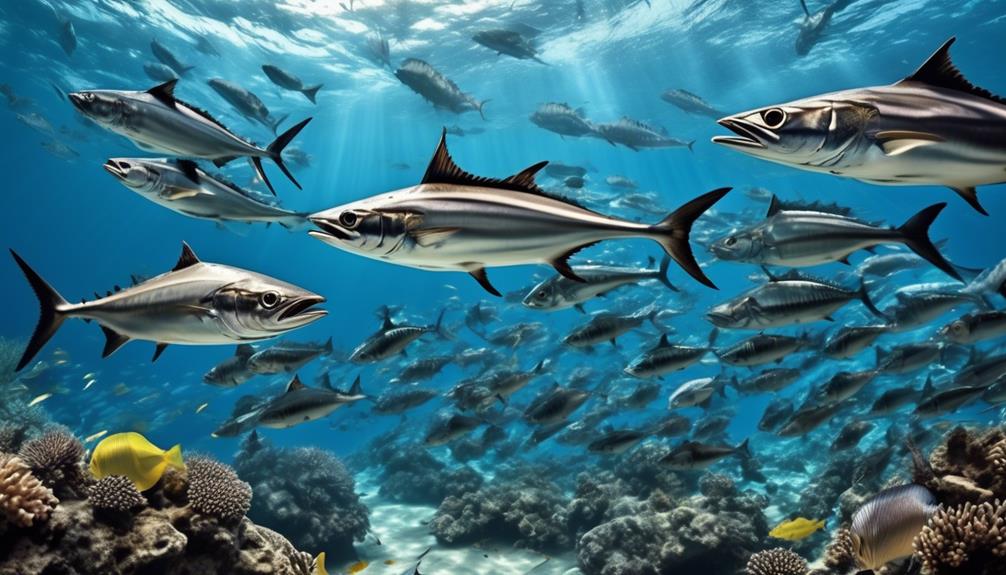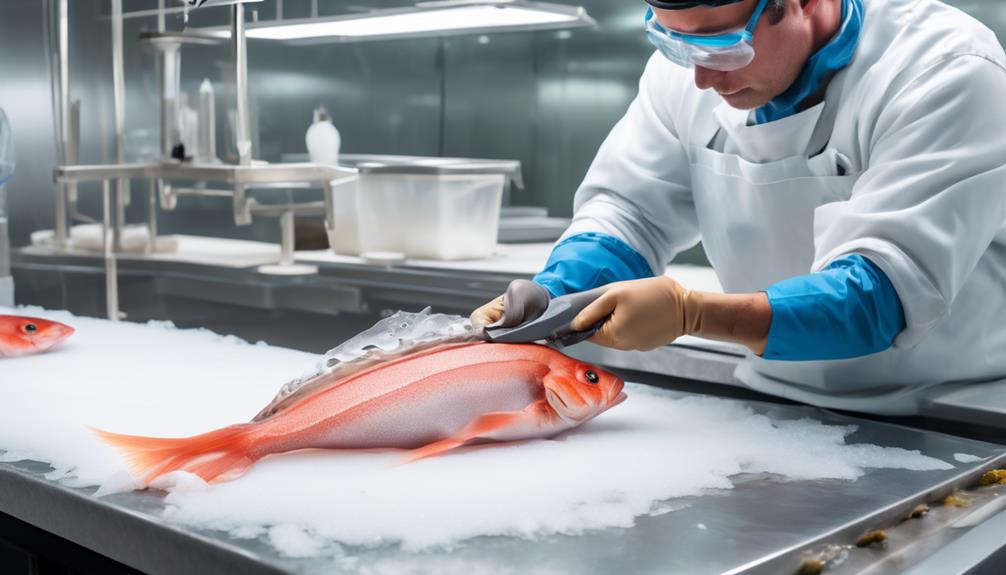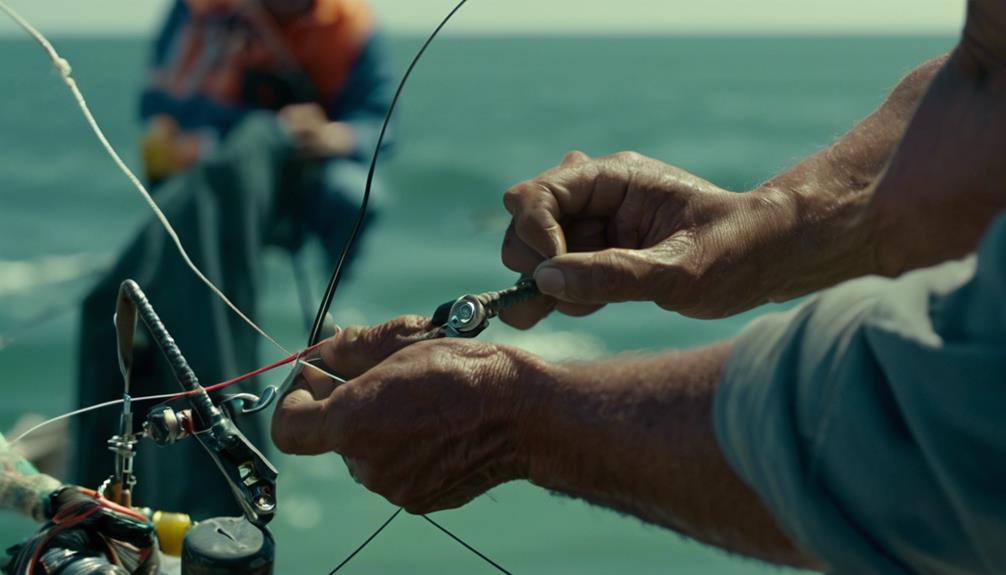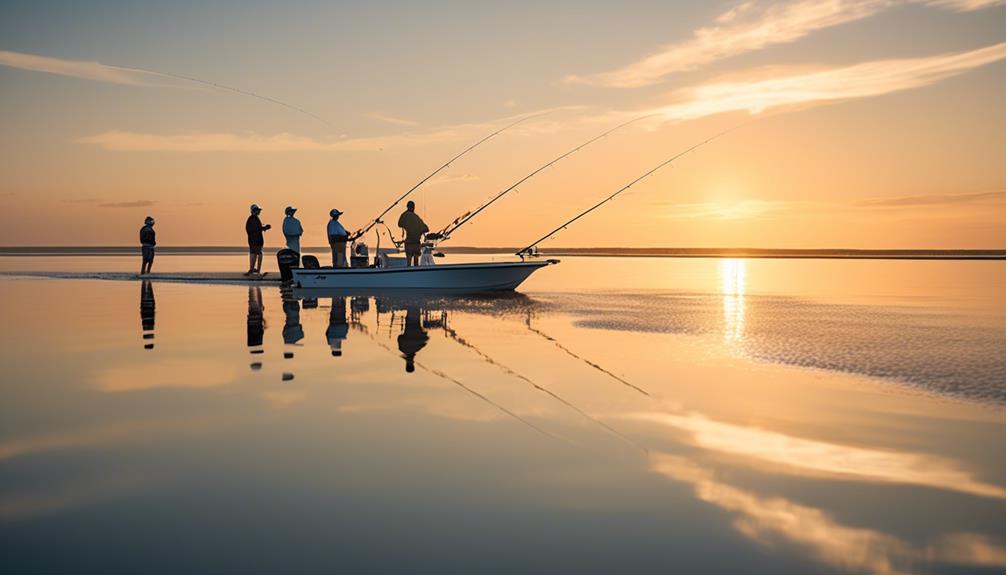Have you ever wondered what truly drives the migration patterns of saltwater fishing species? While many theories exist, the complexity of this phenomenon continues to intrigue scientists and fishermen alike.
From environmental factors to human impact, a multitude of influences may play a role in shaping the movements of these aquatic creatures. Understanding the intricacies of these drivers is not only crucial for the conservation of marine ecosystems but also holds significant implications for the fishing industry.
Environmental Factors
When considering the migration patterns of saltwater fishing species, environmental factors play a crucial role in determining their movements and behaviors. Climate change has significantly impacted the migration patterns of saltwater fishing species. As ocean temperatures rise, many species are forced to seek cooler waters, altering their traditional migration routes. This has a direct impact on fishing patterns and the livelihoods of those who depend on these species for sustenance or commerce.
Additionally, habitat loss due to human activities such as coastal development and pollution has disrupted the natural environment of these species. The destruction of important breeding and feeding grounds can lead to changes in migration patterns as fish seek out new habitats.
Climate change has led to alterations in ocean currents and water temperatures, affecting the distribution of food sources and influencing the timing of migrations. As a result, fishermen must adapt to these changes, altering their strategies and techniques to effectively catch the species they target. Furthermore, habitat loss has forced some species to migrate to areas that may be less suitable for their survival, leading to potential declines in population numbers.
Understanding the impact of climate change and habitat loss on the migration patterns of saltwater fishing species is crucial for the conservation and management of these valuable resources. By recognizing the influence of environmental factors, policymakers and stakeholders can work towards sustainable solutions that support both the needs of the species and those who depend on them.
Seasonal Changes
Seasonal changes in ocean temperatures and currents directly impact the migration patterns of saltwater fishing species, requiring fishermen to adjust their strategies accordingly. Migration triggers, such as temperature shifts and changes in daylight length, prompt fish to move to their preferred habitats for spawning, feeding, or seeking optimal conditions.
For example, as winter approaches and waters cool, many species, like striped bass, migrate southward along the Atlantic coast to warmer waters. Conversely, when summer arrives, these fish migrate northward to cooler waters. Such behavioral adaptations ensure the survival and reproductive success of these species.
Understanding these seasonal changes is crucial for fishermen. They must track the movements of their target species to effectively locate and catch them. For instance, during the summer months, when fish are typically found in northern waters, fishermen need to adjust their fishing locations accordingly.
Feeding and Reproduction
Understanding the feeding and reproduction behaviors of saltwater fishing species is essential for fishermen to effectively target and catch their desired species.
The feeding habits of saltwater fishing species often drive their migration patterns. Many species, such as tuna and mackerel, follow their prey as it moves with changing ocean temperatures.
This means that as a fisherman, knowing the typical migration routes of prey species can help predict the movement of the target species. For example, during the summer, when certain baitfish move closer to the shore, predatory species like striped bass and bluefish follow, providing excellent fishing opportunities for those targeting these species.
Reproductive behavior also plays a significant role in the migration patterns of saltwater fishing species. Many species migrate to specific areas to spawn, as these locations provide the ideal conditions for their offspring to survive.
For instance, some species migrate from the open ocean to coastal areas to lay their eggs, while others may migrate from estuaries to the open ocean. Understanding these reproductive migration patterns can aid fishermen in identifying prime locations for catching specific species during their spawning seasons.
Ocean Currents
To understand the migration patterns of saltwater fishing species, it's essential to grasp the influence of ocean currents on their movements. Ocean currents play a crucial role in shaping fish behavior and the dynamics of marine ecosystems. These currents act as highways for fish, guiding their movements and influencing their distribution patterns.
Fish behavior is closely tied to ocean currents. Many species of saltwater fish have evolved to take advantage of these natural flows of water. For instance, some fish use ocean currents to migrate to spawning grounds or feeding areas. They may ride these currents to conserve energy during long journeys or to seek out more favorable environmental conditions. The presence of specific ocean currents can also signal the availability of food sources, leading fish to aggregate in certain areas within marine ecosystems.
In marine ecosystems, ocean currents help regulate temperature and nutrient distribution, which in turn affects the distribution and abundance of fish and other marine life. For example, upwelling caused by ocean currents can bring nutrient-rich waters to the surface, fueling the growth of phytoplankton and supporting a rich food web that attracts a variety of fish species.
Additionally, the movement of ocean currents can impact the connectivity between different marine habitats, influencing the dispersal of fish larvae and the overall population dynamics of saltwater fishing species.
Temperature Variations
Have you ever noticed how temperature changes in the ocean affect the behavior of saltwater fishing species? Temperature plays a crucial role in shaping the migration patterns and distribution of marine species, impacting their breeding, feeding, and overall survival.
Here are some key factors related to temperature variations that influence the behavior of saltwater fishing species:
- Climate Change and Habitat Loss
- Rising sea temperatures due to climate change can lead to habitat loss for many saltwater fishing species. As temperatures increase, certain areas may become uninhabitable for these species, forcing them to migrate in search of suitable conditions. This can disrupt established migration patterns and impact the availability of fish in specific regions, affecting both commercial and recreational fishing activities.
- Ocean Acidification and Salinity Levels
- Changes in temperature can also influence ocean acidification and salinity levels, which in turn affect the physiology and behavior of saltwater fishing species. Acidification can impact the availability of food sources and the development of fish larvae, while fluctuating salinity levels can alter the distribution of species and their prey.
Understanding the intricate relationship between temperature variations and the behavior of saltwater fishing species is essential for effective fisheries management and conservation efforts. By monitoring and addressing the impacts of climate change, habitat loss, ocean acidification, and salinity fluctuations, we can work towards ensuring the sustainability of marine ecosystems and the long-term viability of saltwater fishing.
Spawning Grounds
Spawning grounds play a crucial role in the life cycle of saltwater fishing species, serving as essential locations for reproductive activities. These grounds are vital for the continuation of genetic adaptation and the maintenance of population dynamics within the species. The selection of suitable spawning grounds is influenced by various factors, including water temperature, salinity, and the presence of suitable habitat for egg fertilization and larval development.
Genetic adaptation is a key aspect of spawning grounds for saltwater fishing species. These locations provide the necessary environmental cues for the species to adapt genetically to their specific spawning habitats. Over time, the genetic traits of the populations may evolve in response to the unique conditions of their spawning grounds, enhancing their reproductive success and survival.
Furthermore, spawning grounds significantly influence population dynamics. The abundance and distribution of suitable spawning grounds directly impact the size and structure of fish populations. Access to high-quality spawning grounds can lead to increased reproductive success, contributing to larger population sizes. Conversely, the degradation or loss of spawning grounds can have detrimental effects on population dynamics, potentially leading to declines in fish populations.
Understanding the significance of spawning grounds is crucial for the conservation and management of saltwater fishing species. By protecting and preserving these essential locations, we can ensure the continued genetic adaptation and sustainable population dynamics of these valuable species.
Predatory Behavior

Saltwater fishing species exhibit a diverse range of predatory behaviors, shaping their interactions within marine ecosystems and influencing their feeding habits. Understanding their predatory behavior is crucial to comprehending their impact on the marine food web.
Here's what you should know about the predatory behavior of saltwater fishing species:
- Prey Selection
Saltwater fishing species showcase varying preferences when it comes to prey selection. Some species are generalists and will consume a wide range of prey, while others are specialists and target specific types of prey. Understanding their prey selection helps in predicting their impact on different prey populations and overall ecosystem dynamics.
- Hunting Strategies
These species employ a variety of hunting strategies to capture their prey. Ambush predators lie in wait for unsuspecting prey, while active predators pursue their prey. Understanding their hunting strategies provides insight into their foraging behavior and the energy they invest in acquiring food.
- Feeding Adaptations
Saltwater fishing species have evolved specific adaptations for capturing and consuming prey. These adaptations can include specialized jaws for crushing shells, elongated bodies for swift pursuit, or camouflage for stealthy ambushes. Understanding these feeding adaptations sheds light on the intricate relationship between predators and their prey, as well as their coevolutionary dynamics.
Human Impact
With increasing commercial and recreational fishing activities, human impact on the migration patterns of saltwater fishing species has become a significant concern for marine conservation efforts. Commercial fishing, in particular, has had a substantial influence on the migration behavior of these species. The large-scale extraction of fish from their natural habitats can disrupt their migration patterns, leading to population declines and altering the ecosystems they inhabit. Additionally, the use of certain fishing gear, such as bottom trawling, can damage essential habitats like coral reefs and seagrass beds, further impacting the migratory routes of saltwater fishing species.
Pollution impact is another critical aspect of human influence on the migration patterns of saltwater fishing species. Pollution, including plastic waste, oil spills, and chemical runoff, can have detrimental effects on the health of these species and the environments through which they migrate. For instance, pollution can contaminate breeding grounds, disrupt food sources, and even directly harm the fish themselves, leading to changes in their migration behaviors as they seek out healthier environments.
Understanding and mitigating these human impacts on saltwater fishing species' migration patterns is crucial for their conservation. Implementing sustainable fishing practices, regulating commercial fishing activities, and reducing pollution in marine environments are essential steps in ensuring the continued health and stability of these species and the ecosystems they inhabit.
Frequently Asked Questions
How Do Migration Patterns of Saltwater Fishing Species Affect Local Economies and Fishing Industries?
Migration patterns of saltwater fishing species significantly impact local economies and fishing industries. Understanding these patterns can lead to economic growth, technological advancements, and conservation strategies. Climate influence and marine ecosystems play crucial roles in migration preservation.
Are There Any New Technologies or Methods Being Developed to Track and Study the Migration Patterns of Saltwater Fishing Species?
New technologies and tracking methods are revolutionizing the study of saltwater fishing species migration patterns. These advancements help researchers understand environmental impacts, climate change effects, and develop conservation measures and management strategies for sustainable fishing practices.
How Do Migration Patterns of Saltwater Fishing Species Impact Other Marine Species and Ecosystems?
Migration patterns of saltwater fishing species impact biodiversity and ecological balance. Climate change and habitat loss further complicate this. Understanding these impacts is crucial for managing marine ecosystems and sustaining fish populations.
What Role Do Natural Disasters and Extreme Weather Events Play in Influencing the Migration Patterns of Saltwater Fishing Species?
Extreme weather events and natural disasters, like hurricanes and temperature changes, directly impact the migration patterns of saltwater fishing species. These shifts affect the availability of fish for fishermen, making it vital to understand the role of climate.
Are There Any Conservation Efforts or Management Strategies in Place to Protect and Preserve the Migration Routes of Saltwater Fishing Species?
There are several conservation efforts and management strategies in place to protect and preserve the migration routes of saltwater fishing species. These include marine protected areas, sustainable fishing practices, and research into migration patterns.
Conclusion
So, what drives migration patterns of saltwater fishing species?
It's a combination of environmental factors, seasonal changes, feeding and reproduction needs, ocean currents, temperature variations, spawning grounds, predatory behavior, and human impact.
These factors all play a role in shaping the movement and behavior of saltwater fishing species, making it important for us to understand and consider them when managing and conserving these valuable resources.



